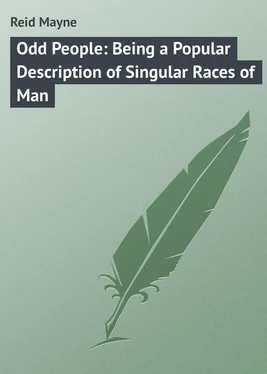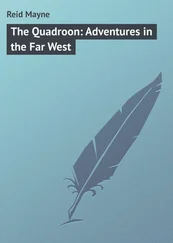Mayne Reid - Odd People - Being a Popular Description of Singular Races of Man
Здесь есть возможность читать онлайн «Mayne Reid - Odd People - Being a Popular Description of Singular Races of Man» — ознакомительный отрывок электронной книги совершенно бесплатно, а после прочтения отрывка купить полную версию. В некоторых случаях можно слушать аудио, скачать через торрент в формате fb2 и присутствует краткое содержание. Жанр: foreign_prose, на английском языке. Описание произведения, (предисловие) а так же отзывы посетителей доступны на портале библиотеки ЛибКат.
- Название:Odd People: Being a Popular Description of Singular Races of Man
- Автор:
- Жанр:
- Год:неизвестен
- ISBN:нет данных
- Рейтинг книги:4 / 5. Голосов: 1
-
Избранное:Добавить в избранное
- Отзывы:
-
Ваша оценка:
- 80
- 1
- 2
- 3
- 4
- 5
Odd People: Being a Popular Description of Singular Races of Man: краткое содержание, описание и аннотация
Предлагаем к чтению аннотацию, описание, краткое содержание или предисловие (зависит от того, что написал сам автор книги «Odd People: Being a Popular Description of Singular Races of Man»). Если вы не нашли необходимую информацию о книге — напишите в комментариях, мы постараемся отыскать её.
Odd People: Being a Popular Description of Singular Races of Man — читать онлайн ознакомительный отрывок
Ниже представлен текст книги, разбитый по страницам. Система сохранения места последней прочитанной страницы, позволяет с удобством читать онлайн бесплатно книгу «Odd People: Being a Popular Description of Singular Races of Man», без необходимости каждый раз заново искать на чём Вы остановились. Поставьте закладку, и сможете в любой момент перейти на страницу, на которой закончили чтение.
Интервал:
Закладка:
But the doctor forgets that it is but from “the specimens brought to Europe” that the above standard of the Bushman’s height has been derived, but from the testimony of numerous travellers – many of them as trustworthy as the doctor himself – from actual measurements made by them upon the spot. It is hardly to be believed that such men as Sparmann and Burchell, Barrow and Lichtenstein, Harris, Campbell, Patterson, and a dozen others that might be mentioned, should all give an erroneous testimony on this subject. These travellers have differed notoriously on other points, but in this they all agree, that a Bushman of five feet in height is a tall man in his tribe. Dr Livingstone speaks of Bushmen “six feet high,” and these are the tribes lately discovered living so far north as the Lake Nagami. It is doubtful whether these are Bushmen at all. Indeed, the description given by the doctor, not only of their height and the colour of their skin, but also some hints about their intellectual character, would lead to the belief that he has mistaken some other people for Bushmen. It must be remembered that the experience of this great traveller has been chiefly among the Bechuana tribes, and his knowledge of the Bushman proper does not appear to be either accurate or extensive. No man is expected to know everybody; and amid the profusion of new facts, which the doctor has so liberally laid before the world, it would be strange if a few inaccuracies should not occur. Perhaps we should have more confidence if this was the only one we are enabled to detect; but the doctor also denies that there is anything either terrific or majestic in the “roaring of the lion.” Thus speaks he: “The same feeling which has induced the modern painter to caricature the lion has led the sentimentalist to consider the lion’s roar as the most terrific of all earthly sounds. We hear of the ‘majestic roar of the king of beasts.’ To talk of the majestic roar of the lion is mere majestic twaddle.”
The doctor is certainly in error here. Does he suppose that any one is ignorant of the character of the lion’s roar? Does he fancy that no one has ever heard it but himself? If it be necessary to go to South Africa to take the true measure of a Bushman, it is not necessary to make that long journey in order to obtain a correct idea of the compass of the lion’s voice. We can hear it at home in all its modulations; and any one who has ever visited the Zoological Gardens in Regent’s Park – nay, any one who chances to live within half a mile of that magnificent menagerie – will be very much disposed to doubt the correctness of the doctor’s assertion. If there be a sound upon the earth above all others “majestic,” a noise above all others “terrific,” it is certainly the roar of the lion. Ask Albert Terrace and Saint John’s Wood!
But let us not be too severe upon the doctor. The world is indebted to him much more than to any other modern traveller, and all great men indulge occasionally in the luxury of an eccentric opinion. We have brought the point forward here for a special purpose, – to illustrate a too much neglected truth. Error is not always on the side of exaggeration ; but is sometimes also found in the opposite extreme of a too-squeamish moderation. We find the learned Professor Lichtenstein ridiculing poor old Hernandez, the natural historian of Mexico, for having given a description of certain fabulous animals — fabulous , he terms them, because to him they were odd and unknown. But it turns out that the old author was right, and the animals exist ! How many similar misconceptions might be recorded of the Buffons, and other closet philosophers – urged, too, with the most bitter zeal! Incredulity carried too far is but another form of credulity.
But to return to our proper theme, and complete the portrait of the Bushman. We have given his height. It is in tolerable proportion to his other dimensions. When young, he appears stout enough; but this is only when a mere boy. At the age of sixteen he has reached all the manhood he is ever destined to attain; and then his flesh disappears; his body assumes a meagre outline; his arms and limbs grow thin; the calf disappears from his legs; the plumpness from his cheeks; and altogether he becomes as wretched-looking an object as it is possible to conceive in human shape. Older, his skin grows dry, corrugated, and scaly; his bones protrude; and his knee, elbow, and ankle-joints appear like horny knobs placed at the ends of what more resemble long straight sticks than the arms and limbs of a human being.
The colour of this creature may be designated a yellow-brown, though it is not easy to determine it to a shade. The Bushman appears darker than he really is; since his skin serves him for a towel, and every species of dirt that discommodes his fingers he gets rid of by wiping it off on his arms, sides, or breast. The result is, that his whole body is usually coated over with a stratum of grease and filth, which has led to the belief that he regularly anoints himself – a custom common among many savage tribes. This, however, the Bushman does not do: the smearing toilet is merely occasional or accidental, and consists simply in the fat of whatever flesh he has been eating being transferred from his fingers to the cuticle of his body. This is never washed off again – for water never touches the Bushman’s hide. Such a use of water is entirely unknown to him, not even for washing his face. Should he have occasion to cleanse his hands – which the handling of gum or some like substance sometimes compels him to do – he performs the operation, not with soap and water, but with the dry dung of cattle or some wild animal. A little rubbing of this upon his skin is all the purification the Bushman believes to be needed.
Of course, the dirt darkens his complexion; but he has the vanity at times to brighten it up – not by making it whiter – but rather a brick-red. A little ochreous earth produces the colour he requires; and with this he smears his body all over – not excepting even the crown of his head, and the scant stock of wool that covers it.
Bushmen have been washed. It requires some scrubbing, and a plentiful application either of soda or soap, to reach the true skin and bring out the natural colour; but the experiment has been made, and the result proves that the Bushman is not so black as, under ordinary circumstances, he appears. A yellow hue shines through the epidermis, somewhat like the colour of the Chinese, or a European in the worst stage of jaundice – the eye only not having that complexion. Indeed, the features of the Bushman, as well as the Hottentot, bear a strong similarity to those of the Chinese, and the Bushman’s eye is essentially of the Mongolian type. His hair, however, is entirely of another character. Instead of being long, straight, and lank, it is short, crisp, and curly, – in reality, wool. Its scantiness is a characteristic; and in this respect the Bushman differs from the woolly-haired tribes both of Africa and Australasia. These generally have “fleeces” in profusion, whereas both Hottentot and Bushman have not enough to half cover their scalps; and between the little knot-like “kinks” there are wide spaces without a single hair upon them. The Bushman’s “wool” is naturally black, but red ochre and the sun soon convert the colour into a burnt reddish hue.
The Bushman has no beard or other hairy encumbrances. Were they to grow, he would root them out as useless inconveniences. He has a low-bridged nose, with wide flattened nostrils; an eye that appears a mere slit between the eyelids; a pair of high cheek-bones, and a receding forehead. His lips are not thick, as in the negro, and he is furnished with a set of fine white teeth, which, as he grows older, do not decay, but present the singular phenomenon of being regularly worn down to the stumps – as occurs to the teeth of sheep and other ruminant animals.
Читать дальшеИнтервал:
Закладка:
Похожие книги на «Odd People: Being a Popular Description of Singular Races of Man»
Представляем Вашему вниманию похожие книги на «Odd People: Being a Popular Description of Singular Races of Man» списком для выбора. Мы отобрали схожую по названию и смыслу литературу в надежде предоставить читателям больше вариантов отыскать новые, интересные, ещё непрочитанные произведения.
Обсуждение, отзывы о книге «Odd People: Being a Popular Description of Singular Races of Man» и просто собственные мнения читателей. Оставьте ваши комментарии, напишите, что Вы думаете о произведении, его смысле или главных героях. Укажите что конкретно понравилось, а что нет, и почему Вы так считаете.












